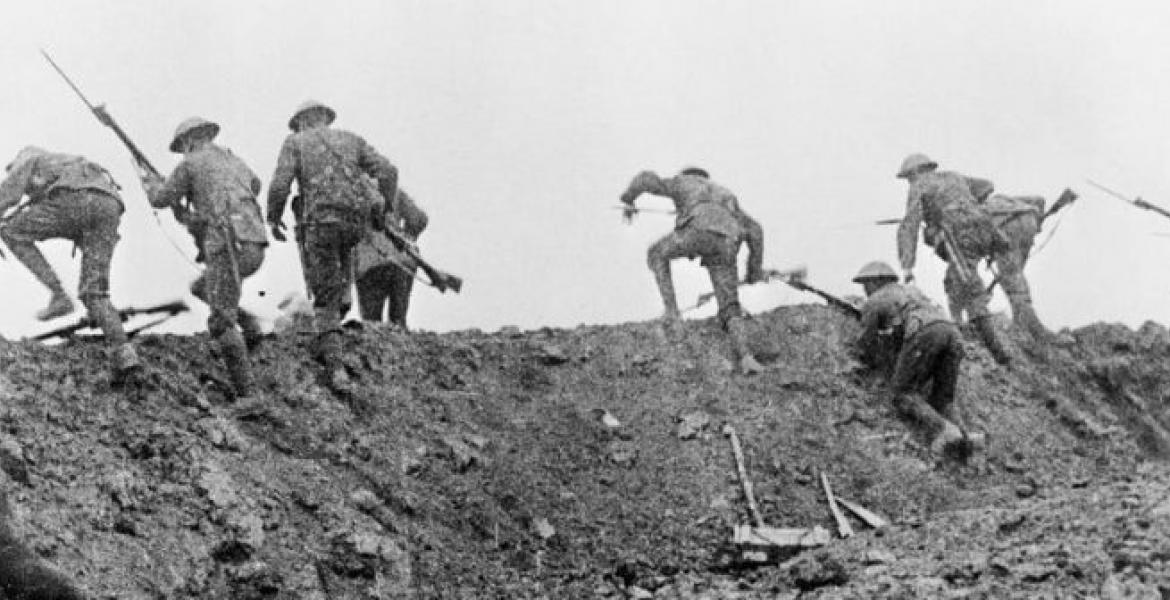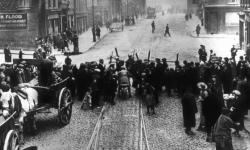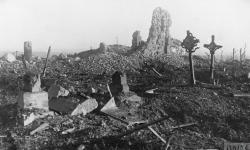The Battle of the Somme
Key facts about the Battle of the Somme
- The Battle of the Somme was fought over 141 days, between 1 July 1916 and 18 November 1916.
- It was the largest military encounter to date and involved British
 Which included regiments from Australia, New Zealand, Canada, India, South Africa, the Caribbean, and Newfoundland (which didn't become a part of the Canadian confederation until 1949 – before that, it was a British colony). and French forces attacking a 20-mile stretch of German defences.
Which included regiments from Australia, New Zealand, Canada, India, South Africa, the Caribbean, and Newfoundland (which didn't become a part of the Canadian confederation until 1949 – before that, it was a British colony). and French forces attacking a 20-mile stretch of German defences. - Some 1.5 million men fought in the battle.
- It was one of the bloodiest battles of the First World War and to many it represents the futility of the war.
- Historians are divided about whether it was a success or failure, and whether the commanders were wise men or idiots.
People you need to know
- Erich von Falkenhayn – German commander-in-chief until August 1916
- Douglas Haig – commander-in-chief of the British forces
- Joseph Joffre – French commander
- Henry Rawlinson – commander of the British 4th Army, which saw the majority of the fighting on the Somme.
At 7.30 on the morning of 1 July 1916, as the whistles fell silent, men climbed out of their trenchesLong, narrow ditchesLong, narrow ditchesLong, narrow ditches and headed across No Man's LandA stretch of land between the front lines of two opposing armies.A stretch of land between the front lines of two opposing armies.A stretch of land between the front lines of two opposing armies., with the objective of reaching and taking the German lines. So started the Battle of the Somme, remembered as one of the bloodiest British battles of the First World War and possibly one of its most futileWithout any useful result, pointless.Without any useful result, pointless.Without any useful result, pointless.. By the end of the first day, the British Army had suffered 57,470 casualties. 585 prisoners of war, 2,152 missing, 35,493 wounded and 19,240 dead. Almost a fifth of its 100,000-strong attack force had been killed
585 prisoners of war, 2,152 missing, 35,493 wounded and 19,240 dead. Almost a fifth of its 100,000-strong attack force had been killed The other 400,000 amassed troops were held in reserve or were supporting the front line. and some regiments, such as the 1st Newfoundland Regiment that lost 90% of its 790 men, ceased to exist.
The other 400,000 amassed troops were held in reserve or were supporting the front line. and some regiments, such as the 1st Newfoundland Regiment that lost 90% of its 790 men, ceased to exist. John Keegan The First World War London: Random House (1998) p.317. Another regiment to be slaughtered was the reorganised Ulster Volunteer Force, formed to oppose Home Rule (by the illegal use of force if necessary) and who signed up as volunteers en masse on the outbreak of war. Andrew Marr argues that it was their deaths that ultimately led to the partition of Ireland into north and south. (Andrew Marr, The Making of Modern Britain: From Queen Victoria to VE Day, London: Macmillan (2009), p.108) Yet the battle was to drag on, with varying degrees of intensity, for another four-and-a-half months. Eventually, it wasn't the loss of life that ended it, but the mud, which became everyone's main enemy.
John Keegan The First World War London: Random House (1998) p.317. Another regiment to be slaughtered was the reorganised Ulster Volunteer Force, formed to oppose Home Rule (by the illegal use of force if necessary) and who signed up as volunteers en masse on the outbreak of war. Andrew Marr argues that it was their deaths that ultimately led to the partition of Ireland into north and south. (Andrew Marr, The Making of Modern Britain: From Queen Victoria to VE Day, London: Macmillan (2009), p.108) Yet the battle was to drag on, with varying degrees of intensity, for another four-and-a-half months. Eventually, it wasn't the loss of life that ended it, but the mud, which became everyone's main enemy.
The horror of the Somme, and the impact it had not just on the men who served on it, but on those they left behind, has given rise to a number of myths, and divided historical opinion since. For decades people have questioned the wisdom of the offensive: one of the most enduring ideas is that the British were 'lions led by donkeys', that brave and honourable men were sacrificed on the orders of their bumbling superiors. Yet some have revised this judgement, declaring it to be an Allied victory, or at least the start of the beginning of the end of the war. But as with most aspects of the First World War, there is no easy answer, and as long as popular memory endures, so too will the debate.
Why the Somme?
The location for the great push was chosen at the Chantilly Conference on 5 December 1915 as the place where the French and British forces met, along either side of the River Somme. Haig had initially wanted an offensive further north in FlandersThe modern area of northern Belgium and historically a territory in the Low Countries.The modern area of northern Belgium and historically a territory in the Low CountriesA region in western Europe which includes Belgium and the Netherlands..The modern area of northern Belgium and historically a territory in the Low CountriesA region in western Europe which includes Belgium and the Netherlands.., where British communications were better and success would enable the Allies to flank the Germans and reduce German access to the sea. Instead, the French commander Joffre pushed for the strategically unimportant Somme region, and Haig, as the junior partner, agreed. However, once the Germans attacked Verdun in February 1916, the French forces were redirected to man the defences there, reducing their size and strength along the Somme and taking their line of attack from twenty-five miles to just eight.
From the very outset, the aims and reasons for the Somme offensive were confused. To those with a background in infantrySoldiers who fight on foot.Soldiers who fight on foot.Soldiers who fight on foot., such as Sir Henry Rawlinson, the aim was 'to kill as many Germans as possible with the least loss to ourselves,' and Brigadier-General Sir John Charteris wrote in his diary on 30 June 1916 that 'We are fighting primarily to wear down the German armies and the German nation.' Quoted in Niall Ferguson The Pity of War, London: Penguin (1998), p.292 In this manner, the Germans would run out of resources and manpower in defence and counter-attacks.
Quoted in Niall Ferguson The Pity of War, London: Penguin (1998), p.292 In this manner, the Germans would run out of resources and manpower in defence and counter-attacks. Targets were even set in December 1915 to cause 200,000 German casualties a month. However, Haig, whose background was as a cavalryman, felt that a massive breakthrough of the German lines would provide the easiest way to win the war. After all, he reasoned, a war of attritionA prolonged period of conflict during which each side seeks to wear down the other by a series of small-scale actions.A prolonged period of conflict during which each side seeks to wear down the other by a series of small-scale actions.A prolonged period of conflict during which each side seeks to wear down the other by a series of small-scale actions. would use up Britain's own men as quickly as the Germans', and could do no favours for moraleThe confidence, enthusiasm, and discipline of a person or group at a particular time.The confidence, enthusiasm, and discipline of a person or group at a particular time.The confidence, enthusiasm, and discipline of a person or group at a particular time..
Targets were even set in December 1915 to cause 200,000 German casualties a month. However, Haig, whose background was as a cavalryman, felt that a massive breakthrough of the German lines would provide the easiest way to win the war. After all, he reasoned, a war of attritionA prolonged period of conflict during which each side seeks to wear down the other by a series of small-scale actions.A prolonged period of conflict during which each side seeks to wear down the other by a series of small-scale actions.A prolonged period of conflict during which each side seeks to wear down the other by a series of small-scale actions. would use up Britain's own men as quickly as the Germans', and could do no favours for moraleThe confidence, enthusiasm, and discipline of a person or group at a particular time.The confidence, enthusiasm, and discipline of a person or group at a particular time.The confidence, enthusiasm, and discipline of a person or group at a particular time..
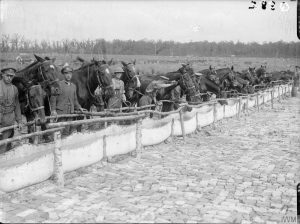
To Haig, the aim of the Somme was to provide that breakthrough. According to him, previous attacks had failed because of lack of weight. If more men and more artilleryLarge guns used in warfare, or referring to the group that uses those guns.Large guns used in warfare, or referring to the group that uses those guns. were piled into the offensive then a breakthrough would be possible: artillery would smash the German lines to pieces, the infantry would march across No Man's Land and mop up what was left, and the cavalryPeople fighting on horseback, who were therefore more mobile than foot soldiers. In modern warfare, the cavalry are those fighting in armoured vehicles.People fighting on horseback, who were therefore more mobile than foot soldiers. In modern warfare, the cavalry are those fighting in armoured vehicles.People fighting on horseback, who were therefore more mobile than foot soldiers. In modern warfare, the cavalry are those fighting in armoured vehicles. would stream through the gap and take the land up to seven miles beyond. Despite its complete lack of use in trench warfare, cavalry was still believed by some to be the best option wherever possible, and hundreds of thousands of horses were kept in France for this purpose. Their food, according to AJP Taylor took up more shipping space than was lost to German submarines. (English History 1914-1945, Oxford: Oxford University Press (1975), p.59). British cavalry did manage a breakthrough on the 14 July near High Wood, but suffered heavy casualties as they couldn't be supported by artillery or infantry. With the direction and purpose of the offensive a patched-together compromise, and with lack of unity and clarity of thought from the British and French command, it was hardly a good start to the offensive.
Despite its complete lack of use in trench warfare, cavalry was still believed by some to be the best option wherever possible, and hundreds of thousands of horses were kept in France for this purpose. Their food, according to AJP Taylor took up more shipping space than was lost to German submarines. (English History 1914-1945, Oxford: Oxford University Press (1975), p.59). British cavalry did manage a breakthrough on the 14 July near High Wood, but suffered heavy casualties as they couldn't be supported by artillery or infantry. With the direction and purpose of the offensive a patched-together compromise, and with lack of unity and clarity of thought from the British and French command, it was hardly a good start to the offensive.
Douglas Haig
The story of the Somme is almost always, and with good cause, linked to the story of the British commander-in-chief. Douglas Haig has often been criticised for the battle. The number of casualties, for such small gains, has led many to term him 'the butcher of the Somme' and to consider him an optimistic fool who refused to move with the times.
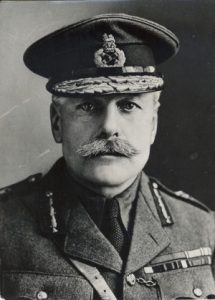
Haig had been commander of the British Expeditionary ForceThe part of the British Army sent to fight in Europe in the First World War and the Second World War.The part of the British Army sent to fight in Europe in the First World War and the Second World WarA global war that lasted from 1939 until 1945..The part of the British Army sent to fight in Europe in the First World War and the Second World WarA global war that lasted from 1939 until 1945. .'s (BEFThe British Expeditionary Force, the part of the British Army sent to fight in Europe in the First World War and the Second World War.The British Expeditionary Force, the part of the British Army sent to fight in Europe in the First World War and the Second World War.The British Expeditionary Force, the part of the British Army sent to fight in Europe in the First World War and the Second World War.) 1st Army, and rose to his position of commander-in-chief in a less-than-honourable fashion. He had married a royal lady-in-waiting who gave him direct access to George V. When the time was right, Haig used his relationship with the king to engineer his predecessorA person who held a job or office before the current holder.A person who held a job or office before the current holder.A person who held a job or office before the current holder; or the thing that came before something else. 's downfall and offer himself as an alternative. His predecessor was John French, who had taken the BEF to France at the beginning of the war, and witnessed its absolute destruction – there had been 90,000 casualties by the end of November 1914. When George V visited France in October 1915, Haig very bluntly told him that French was 'a source of great weakness to the army' and suggested himself as French's successor. (quoted in Keegan, The First World War, p.310). His strategy worked: on 16 December 1915, Haig became overall commander of the British forces.
His predecessor was John French, who had taken the BEF to France at the beginning of the war, and witnessed its absolute destruction – there had been 90,000 casualties by the end of November 1914. When George V visited France in October 1915, Haig very bluntly told him that French was 'a source of great weakness to the army' and suggested himself as French's successor. (quoted in Keegan, The First World War, p.310). His strategy worked: on 16 December 1915, Haig became overall commander of the British forces.
His record on the Somme was questionable at best: many have argued that his tactics were wrong, and that his optimismHopefulness and confidence about the future or the success of something.Hopefulness and confidence about the future or the success of something.Hopefulness and confidence about the future or the success of something. made him overlook obvious weaknesses in the British army and the strengths of the German. However, as Sheffield has pointed out, this was his first major battle and as such he was still finding his feet, but perhaps the lessons he learnt helped to improve the British army so that they were more likely to win thereafter.
Haig had a deep belief in himself and his role, which he believed was shared by the soldiers serving under him, inspiring them to strive for greater heights and to bear harsher lows. This faith, which included a belief that he had spoken to Napoleon through a séance and that God had chosen him to fulfil a particular destiny, seems to have informed his actions. He could seem harsh and 'to move through the horrors of the First World War as if guided by some inner voice, speaking of a higher purpose and a personal destiny', Keegan, The First World War, p.311 yet he was also always willing to stop to talk to the average TommyA British private soldier.A British private soldier.A British private soldier.. Perhaps his sense of destiny made him unwilling to change strategy, even when it wasn't working, and added to his overly-optimistic view of the battle.
Keegan, The First World War, p.311 yet he was also always willing to stop to talk to the average TommyA British private soldier.A British private soldier.A British private soldier.. Perhaps his sense of destiny made him unwilling to change strategy, even when it wasn't working, and added to his overly-optimistic view of the battle.
Preparations
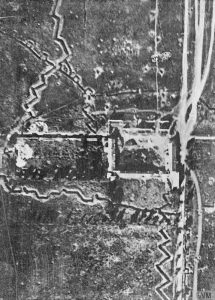
The Germans were in a good position along the Somme, with 30-foot deep trenches that were impervious to artillery fire and with enough provisions to withstand a siegeA military operation in which enemy forces surround a town or building, cutting off essential supplies, with the aim of compelling those inside to surrender.A military operation in which enemy forces surround a town or building, cutting off essential supplies, with the aim of compelling those inside to surrender.A military operation in which enemy forces surround a town or building, cutting off essential supplies, with the aim of compelling those inside to surrender.. Their dugoutsTrenches that are dug and roofed over as a shelter for troops.Trenches that are dug and roofed over as a shelter for troops.TrenchesLong, narrow ditches that are dug and roofed over as a shelter for troops. were linked to the rear by deep communications trenches and buried telephone lines, and were protected by machine gun posts and barbed wire. The British Official History likened the German position to a fortress and at least in part blamed the lack of use of appropriate siege techniques – such as a concentration of artillery on strategically important points – for the disasters that followed. The Germans also held – and had held since the 'race for the sea' in 1914 – the higher ground. This gave them an excellent view of the Allies' actions and allowed them to prepare for the expected attack, A good view of the Allied preparations wasn't the only hint the Germans had of an attack: a censorship error had led a rousing speech given by the Minister of Labour, Arthur Henderson, to munitions workers on 2 June to be published. as well as giving them a distinct tactical advantage.
A good view of the Allied preparations wasn't the only hint the Germans had of an attack: a censorship error had led a rousing speech given by the Minister of Labour, Arthur Henderson, to munitions workers on 2 June to be published. as well as giving them a distinct tactical advantage. It's always harder to attack uphill. The Allied preparations were in fact so easy to see that the German commander, Falkenhayn, thought they were too blatant to be true. Perhaps one saving grace for those at the start of the battle was that he withheld many reserves until 5 July, expecting the main attack to be elsewhere. 500,000 British men were gathered along the Somme front in preparation for the offensive.
It's always harder to attack uphill. The Allied preparations were in fact so easy to see that the German commander, Falkenhayn, thought they were too blatant to be true. Perhaps one saving grace for those at the start of the battle was that he withheld many reserves until 5 July, expecting the main attack to be elsewhere. 500,000 British men were gathered along the Somme front in preparation for the offensive.
Although some were experienced regulars from the depleted BEF, many more were the 'enthusiastic amateurs' C. E. Carrington, Soldier from the Wars Returning, London: Hutchinson (1965) p.120 from Kitchener's New Army of Pals battalionsIn the First World War, battalions of friends and colleagues from the same towns who had signed up to the army together.In the First World War, battalions of friends and colleagues from the same towns who had signed up to the army together.In the First World War, battalions of friends and colleagues from the same towns who had signed up to the army together.. The Pals had little experience of war, and were made up of citizens who had volunteered for the army at its outbreak. They had been given training, but most had little experience of enemy combat.
C. E. Carrington, Soldier from the Wars Returning, London: Hutchinson (1965) p.120 from Kitchener's New Army of Pals battalionsIn the First World War, battalions of friends and colleagues from the same towns who had signed up to the army together.In the First World War, battalions of friends and colleagues from the same towns who had signed up to the army together.In the First World War, battalions of friends and colleagues from the same towns who had signed up to the army together.. The Pals had little experience of war, and were made up of citizens who had volunteered for the army at its outbreak. They had been given training, but most had little experience of enemy combat.
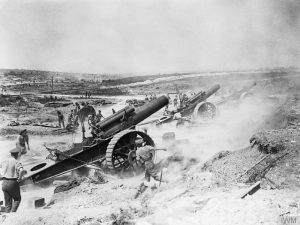
The enemy trenches were bombarded for a week before the assault in the hope that it would render the Germans ineffective and shocked into inactivity. Joffre pushed for preparatory attacks, believing they would occupy the German reserves, making the main push likely to be more successful. Haig was opposed to the idea, and in this instance carried his point. In the days running up to 1 July 1916, more than three million shells were taken to the front, to feed one and a half thousand guns and howitzers. Between the start of the bombardment on 24 June 1916 and the commencement of the main offensive on 1 July, 1.7 million shells were fired by the 4th Army.
Joffre pushed for preparatory attacks, believing they would occupy the German reserves, making the main push likely to be more successful. Haig was opposed to the idea, and in this instance carried his point. In the days running up to 1 July 1916, more than three million shells were taken to the front, to feed one and a half thousand guns and howitzers. Between the start of the bombardment on 24 June 1916 and the commencement of the main offensive on 1 July, 1.7 million shells were fired by the 4th Army. Of which about 30% were duds. The quality and quantity of munitions production improved during the war, as British society adapted to a war footing. Although 1.7 million seems significant, it was small in comparison to the number used in later battles
Of which about 30% were duds. The quality and quantity of munitions production improved during the war, as British society adapted to a war footing. Although 1.7 million seems significant, it was small in comparison to the number used in later battles At Messines a year later, over 3.2 million shells were fired. and was too widely spread to be effective. Field guns would help cut the barbed wire that would be a literal death trap if left, and night-time raids were conducted by groups along the front to clear what remained. Reports of their success varied, and in several places were not favourable; even Haig worried about the amount of wire left to be cut on 30 June. This was compounded by false reports, such as that of General Hunter-Weston, who said that the wire-cutting was so successful that his troops could 'walk in' to the German trenches, when one of his junior officers 'could see it standing strong and well.'
At Messines a year later, over 3.2 million shells were fired. and was too widely spread to be effective. Field guns would help cut the barbed wire that would be a literal death trap if left, and night-time raids were conducted by groups along the front to clear what remained. Reports of their success varied, and in several places were not favourable; even Haig worried about the amount of wire left to be cut on 30 June. This was compounded by false reports, such as that of General Hunter-Weston, who said that the wire-cutting was so successful that his troops could 'walk in' to the German trenches, when one of his junior officers 'could see it standing strong and well.' Quoted in Keegan, The First World War, p.314.
Quoted in Keegan, The First World War, p.314.
1st July 1916: the first day of the Somme
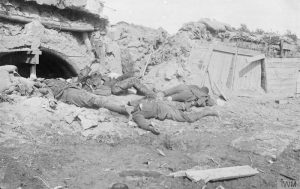
Unfortunately for the thousands of Allied soldiers, the artillery bombardment did not do the job: it didn't clear the German trenches, nor did it cut the wire. Waves of Allied soldiers were cut down by gun fire from the Germans as they crossed No Man's Land, mown down as they tried to get past the barbed wire. Others were hit before they even left British-held territory, the bullets passing through No Man's Land and into those waiting to cross it: the whole of the Tyneside Irish Brigade – some 3,000 men – was brought to a halt in this way, with 500 men of one of its four battalions and 600 from another, being wounded or killed inside British lines. The constant shelling made the ground even more difficult to cross and alerted the Germans to the forthcoming attack. A 'creeping barrageThe firing of artillery just ahead of an advancing army.The firing of artillery just ahead of an advancing army.The firing of artillery just ahead of an advancing army.' ahead of the British troops had been expected to take care of German defenders. While the idea was good, it could never work effectively without tactical radio, An invention of the future as the artillery batteries had no way of knowing where their infantry battalions were. They therefore had to stick to a timetable, based on guesswork, and the barrage was often lifted too soon with men still on the wrong side of the wire, turning them into sitting ducks. In addition, scared of harming their own soldiers, the artillery battalions aimed longer than was helpful. When they did try to correct, the Allied troops feared suffering under friendly fireWeapon fire coming from one's own side which causes injury or death.Weapon fire coming from one's own side which causes injury or death.Weapon fire coming from one's own side which causes injury or death..
An invention of the future as the artillery batteries had no way of knowing where their infantry battalions were. They therefore had to stick to a timetable, based on guesswork, and the barrage was often lifted too soon with men still on the wrong side of the wire, turning them into sitting ducks. In addition, scared of harming their own soldiers, the artillery battalions aimed longer than was helpful. When they did try to correct, the Allied troops feared suffering under friendly fireWeapon fire coming from one's own side which causes injury or death.Weapon fire coming from one's own side which causes injury or death.Weapon fire coming from one's own side which causes injury or death..
The problem with communications went further than just the creeping barrage: without effective and up-to-date intelligence, high command was unable to provide any strategic help to those in the field. They did not know how the battle was progressing on the ground, nor could they quickly change tactics to suit the changes in the battle or to respond to any fresh intelligence if they were lucky enough to receive it. Communication was limited to telephone lines, which had to be laid down as the front advanced, runners, dogs and pigeons (all of which were susceptible to be taken out by bombs or bullets), and flares, which were easy to confuse. The lack of effective communication compounded the problems of command structure and training, which limited the decisions any junior officers or soldiers could make. Liddle however argues for some flexibility in some places along the front, showing some initiative from junior officers and their men. This could partly be because the turnover rate of junior officers during the First World War was incredibly high, so officers did not have the experience or training necessary for effective decision-making. This was added to the very obvious problem that, with the army having expanded so much and so quickly, there just weren't enough officers of any rank with the experience and training needed to be effective.
Liddle however argues for some flexibility in some places along the front, showing some initiative from junior officers and their men. This could partly be because the turnover rate of junior officers during the First World War was incredibly high, so officers did not have the experience or training necessary for effective decision-making. This was added to the very obvious problem that, with the army having expanded so much and so quickly, there just weren't enough officers of any rank with the experience and training needed to be effective.
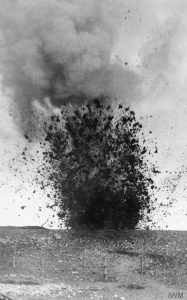
Ferguson argues that the British command structure, whereby position in society could still buy position in the army, as well as the unthinking and unswerving duty to follow orders, no matter how suicidal, led directly to the slaughter of the Somme. Haig, he argues, overturned Rawlinson's original – and better – plan for the Somme offensive in favour of a breakthrough objective, and Rawlinson, as Haig's junior, felt obliged to submit. Gary Sheffield, however, says Rawlinson simply ignored Haig and did what he thought was right, therefore placing much of the blame on him rather than on Haig. Sheffield goes so far to say that if Rawlinson had believed more in Haig, then the Allied forces could have taken twenty miles of German-held territory, and perhaps won the war in 1916. Gary Sheffield, 'The Somme: An Exercise in Futility?', History Today 66 (2016). The commanders of the army, schooled in the old tactics of cavalry and brought up on legends like the Charge of the Light BrigadeA futile British light cavalry action against well-armed and well-prepared Russian forces during the Battle of Balaclava in the Crimean War, resulting in massive losses to the British. , could not – or would not – adapt to a new style of warfare, leaving them completely out of their depth. This made, as AJP Taylor says, the British army 'a clumsy instrument. The senior officers were elderly, unimaginative professionals from the old peacetime army, who refused to contemplate the problems of trench warfare…The junior officers were, for the most part, former public schoolboys. They were expected to set an example to their men, as indeed they did; tactical leadership was held to be beyond them. The men had been trained to man a trench, and to advance in a regular line.'
Gary Sheffield, 'The Somme: An Exercise in Futility?', History Today 66 (2016). The commanders of the army, schooled in the old tactics of cavalry and brought up on legends like the Charge of the Light BrigadeA futile British light cavalry action against well-armed and well-prepared Russian forces during the Battle of Balaclava in the Crimean War, resulting in massive losses to the British. , could not – or would not – adapt to a new style of warfare, leaving them completely out of their depth. This made, as AJP Taylor says, the British army 'a clumsy instrument. The senior officers were elderly, unimaginative professionals from the old peacetime army, who refused to contemplate the problems of trench warfare…The junior officers were, for the most part, former public schoolboys. They were expected to set an example to their men, as indeed they did; tactical leadership was held to be beyond them. The men had been trained to man a trench, and to advance in a regular line.' Taylor, English History 1914-1945, p.59
Taylor, English History 1914-1945, p.59
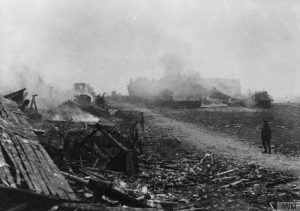
Haig had stated that if the Allies didn't succeed quickly the offensive would be abandoned, but he pushed ahead with it anyway. With military communications much more basic than today, those behind the front lines didn't realise the scale of the bloodshed until days later. He insisted the Germans had been shaken by the first day of the offensive, and perhaps they were, but not by the numbers of their own losses, which by one count were only a tenth of those of the British, but by the enemy's.
With military communications much more basic than today, those behind the front lines didn't realise the scale of the bloodshed until days later. He insisted the Germans had been shaken by the first day of the offensive, and perhaps they were, but not by the numbers of their own losses, which by one count were only a tenth of those of the British, but by the enemy's. The number of German losses has been put at somewhere between 6,000 and 8,000 men. Those too badly wounded to retreat found shell holes to curl into and die. The army had been ordered to abandon the wounded during the advance, and not to stop for any fallen. The momentum of the offensive was not to be broken, either for defence or to help comrades. The Thiepval Monument, the largest such memorial on the Western Front, lists over 72,000 British and South African men who died on the Somme but with no known graves.
The number of German losses has been put at somewhere between 6,000 and 8,000 men. Those too badly wounded to retreat found shell holes to curl into and die. The army had been ordered to abandon the wounded during the advance, and not to stop for any fallen. The momentum of the offensive was not to be broken, either for defence or to help comrades. The Thiepval Monument, the largest such memorial on the Western Front, lists over 72,000 British and South African men who died on the Somme but with no known graves.
There were, however, some successes on the first day of the Somme: the sector immediately astride the River Somme and near Thiepval had taken ground from the Germans Although the Ulster Volunteers who had taken it had to fall back due to lack of support from behind. and the French had made gains in the south. These advances and the promise of success they contained provided the justification for the continuation of the offensive.
Although the Ulster Volunteers who had taken it had to fall back due to lack of support from behind. and the French had made gains in the south. These advances and the promise of success they contained provided the justification for the continuation of the offensive.
The ongoing offensive
The Battle of the Somme was not just about the first day, and it would be many months before it was over. The dramatic figures of that first day were not repeated, but attack after attack was flung at the Germans by the Allies, sometimes on a broad front and others times in concentrated sections, over the following weeks, although there was very little to show for it. By the end of July, the line had moved at best only three miles into German-held territory Although in some places such as north of the Ancre it had hardly moved at all. and the Germans had lost some 160,000 men. The Allies, however, had lost 200,000. But at least for the French, the Somme distracted the Germans from the continued onslaught at Verdun.
Although in some places such as north of the Ancre it had hardly moved at all. and the Germans had lost some 160,000 men. The Allies, however, had lost 200,000. But at least for the French, the Somme distracted the Germans from the continued onslaught at Verdun.
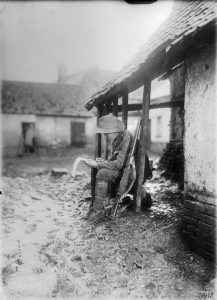
By autumn, the rains turned the lines into sludge, making any movement difficult and the trenches hellish. As the Official History states, 'As September wore to a close, the troops of all arms began to regard the mud as their chief enemy.' By the end of October, a minimum of ten horses were needed just to move a field gun. As one survivor of the Somme put it, 'Mud, for the men in the line, was no mere inorganic nuisance and obstacle. It took on an aggressive, wolf-like guise, and like a wolf could pull down and swallow the lonely wanderer in the darkness.' Quoted in Terraine, ‘The Texture of the Somme’.
Quoted in Terraine, ‘The Texture of the Somme’.
Despite the mud, the British continued to attack and finally took Beaumont Hamel, the place where the Newfoundland regiment had been obliterated almost four months before, on 13 November. This was the last main attack of the Battle, and perhaps the symbolic victory that Haig had been hoping for.
Tank warfare
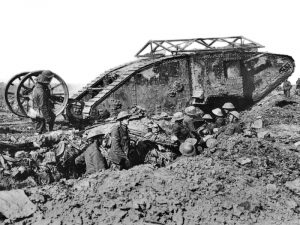
The stalemateWhere neither opponent can make a move or win.Where neither opponent can make a move or win.Where neither opponent can make a move or win. that very quickly arose during the Somme offensive could only hope to be broken by a change in tactics or technology, and the Battle of the Somme is not just famous for its considerable loss of life. It is also famous for the first use of tanks. Named after the water tanks which the British pretended they were designing.
Named after the water tanks which the British pretended they were designing.
The general idea of the tank had been around since Leonardo da Vinci, and had been imagined by H.G. Wells in 1903, but it was the First World War that turned it from an abstract idea into a reality. In September 1916, as part of a co-ordinated attack by all the Allied forces on several fronts, thirty-six tanks crossed the lines in an attempt to take ground from the Germans and jump start the stalled offensive. Initially, they were successful: in one sector near the village of Flers they advanced 3,500 yards against the Germans. The infantry followed close behind and within days the village had been taken providing, as Keegan says, 'one of the cheapest and most spectacular local victories of the war on the Western Front thus far'.
This success was not to last: mechanical problems began to emerge, and many broke down or became stuck on uneven ground and a number were eventually taken out by artillery fire. Most of the tanks that started the day had, by the end of it, been disabled and the infantry, fighting the dogged German resistance from reserve lines, were unable to take full advantage. The use of the tanks has come under criticism, and not just for their mechanical failures. In deploying the tanks in small numbers and before they were ready, the British showed their best weapon to the enemy and lost any future element of surprise. True, they expected very shortly to win the war with this concerted offensive, so continuing subterfugeDeceit used to secure a goal or ambition.Deceit used to secure a goal or ambition.Deceit used to secure a goal or ambition. would not be necessary, but experience by this point should have taught them that a quick end to the war was not possible.
Not just numbers
Tales of the tactical and the political should not overshadow the human stories of those who lived and died on the Somme. The first-hand experiences of those who served during the battle have been preserved in letters, diaries and photos, many of which are held by the Imperial War Museum. Many tell the tales of those who died, and describe the fear, excitement, sense of duty and camaraderie in the trenches. The last thing American poet Alan Seeger (fighting for the French foreign legion) wrote in his diary was 'I am glad to be going in first wave. If you are in this thing at all it is best to be in to the limit. And this is the supreme experience.' He was killed on 4 July 1916. 2nd Lt Percy G. Boswell of the King's Own Yorkshire Light InfantrySoldiers who fight on foot.Soldiers who fight on foot. wrote a letter on the eve of the battle to his father:
Dear Father, I am just writing you a short note which you will receive only if anything has happened to me during the next few days. The Hun is going to get consummate hell just in this quarter and we are going over the parapet tomorrow when I hope to spend a few merry hours in chasing the Boche all over the place. I am absolutely certain that I shall get through all right, but in case the unexpected does happen I shall rest content with the knowledge that I have done my duty – and one can't do more. Goodbye with the best of love to all from PercyImperial War Museum, Docs.9291
Percy was killed the following day, during the first day of the Battle of the Somme, when the Yorkshire Light Infantry lost 80% of their attacking strength. One school teacher-turned-soldier, Bill Nevill, threw footballs over the top to encourage his soldiers forward, offering a reward to whoever was the first to kick them into German trenches. Sadly, he did not live to present the award. Others were luckier, and survived the battle to record their experiences afterwards. War poet Robert Graves served on the Somme, collecting coats from dead Germans for his comrades to keep them warm during the cold nights. His poem, A Dead Boche, was based on his experience:
To you who'd read my songs of War
And only hear of blood and fame,
I'll say (you've heard it said before)
"War's Hell!" and if you doubt the same,
Today I found in Mametz Wood
A certain cure for lust of blood:
Where, propped against a shattered trunk,
In a great mess of things unclean,
Sat a dead Boche; he scowled and stunk
With clothes and face a sodden green,
Big-bellied, spectacled, crop-haired,
Dribbling black blood from nose and beard.
On 20 July Graves was so badly wounded that he was left for dead, and in fact was reported as such. Others lived to tell the tale in other ways: J.R.R. Tolkien, recently graduated from Oxford, spent time on and off the front line, before being injured and sent home in October. He used his experiences as inspiration for his later masterpieces.
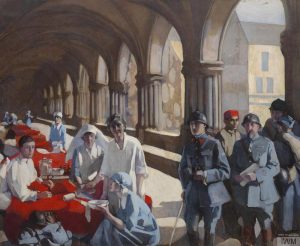
The diary of a British actress, Susan Richmond, who became a nurse as part of the Suffragist-founded Scottish Women's Hospital in Royaumont, The NUWSS had initially approached the British government to offer their medical services, but were turned down because it was deemed improper to have an all-female staff looking after soldiers. Instead, they contacted the French government, who were more than happy for them to help. provides heart-breaking details of the injuries sustained in battle. One patient 'screamed like an animal at every movement. His shell-spattered face was drawn and ghastly, there was a thick stubble on his chin and neck. He had a few shreds of clothes on: one trouser leg and a torn shirt. I wished to heaven they had ripped them right off at the ambulance and sent him in blankets, for it was a terrible ordeal for him to have them removed now, when he was at the end of his endurance.' It also provides details of the hardships experienced by those working in the hospitals behind the front lines. In one extract, Richmond describes the surgeon, Miss Frances Ivens – one of the first women to obtain a Master of Surgery degree - as committed yet absolutely exhausted: 'I don't know when I have seen a face look so utterly wearied out, physically and mentally. She had been operating day and night for a week, with at most three hours sleep in twenty-four.'
The NUWSS had initially approached the British government to offer their medical services, but were turned down because it was deemed improper to have an all-female staff looking after soldiers. Instead, they contacted the French government, who were more than happy for them to help. provides heart-breaking details of the injuries sustained in battle. One patient 'screamed like an animal at every movement. His shell-spattered face was drawn and ghastly, there was a thick stubble on his chin and neck. He had a few shreds of clothes on: one trouser leg and a torn shirt. I wished to heaven they had ripped them right off at the ambulance and sent him in blankets, for it was a terrible ordeal for him to have them removed now, when he was at the end of his endurance.' It also provides details of the hardships experienced by those working in the hospitals behind the front lines. In one extract, Richmond describes the surgeon, Miss Frances Ivens – one of the first women to obtain a Master of Surgery degree - as committed yet absolutely exhausted: 'I don't know when I have seen a face look so utterly wearied out, physically and mentally. She had been operating day and night for a week, with at most three hours sleep in twenty-four.' Susan Richmond, 'Little Short of a Miracle', History Today 56 (2006).
Susan Richmond, 'Little Short of a Miracle', History Today 56 (2006).
As well as the brutal realities of the Somme, some sources also show humour, such as the trench newspaper 'The Wipers Times', which was promptly renamed for a special edition the 'The Somme Times' and published 'sommewhere in France' on 31 July 1916. It shows how comedy was used to lighten the situation, with limericks such as:
There was a young girl of the Somme
Who sat on a number five bomb
She thought 'twas a dud 'un
But it went off sudden –
Her exit she made with aplomb!
and tongue-in-cheek seditionConduct or speech inciting people to rebel against the authority of a state or monarch.Conduct or speech inciting people to rebel against the authority of a state or monarchA king, queen, or emperor.Conduct or speech inciting people to rebel against the authority of a state or monarchA king, queen, or emperor.:
Do you suffer from cheerfulness? Do you wake up in the morning feeling that all is going well for the Allies? Do you sometimes think the war will end in the next twelve months? Do you believe good news in preference to bad? Do you consider our leaders are competent to conduct the war to a successful issue? . . . WE CAN CURE YOU. Two days spent at our establishment will effectually eradicate all traces of that dread disease from your system.Malcolm Brown, 'Sommewhere in France' History Today 56 (2006).
Impact of the Somme
After the Somme, the gung-ho 'Britain rules the waves' optimism of the Victorian era, which stretched back as far as the defeat of Napoleon, gave way to a stark realism. No longer was the war about valourShowing great courage in the face of danger.Showing great courage in the face of danger.Showing great courage in the face of danger. and patriotism, but was about horror, mud and blood. At least, so say Taylor and Keegan. 'The Somme marked the end of an age of vital optimism in British life that has never been recovered.' Keegan, The First World War, p.321 AJP Taylor says, 'Kitchener's army found its graveyard on the Somme. Not only men perished. There perished also the zest and idealism with which nearly three million Englishmen had marched forth to war.'
Keegan, The First World War, p.321 AJP Taylor says, 'Kitchener's army found its graveyard on the Somme. Not only men perished. There perished also the zest and idealism with which nearly three million Englishmen had marched forth to war.' Taylor, English History 1914-1945, p.61 This can partially be seen in the changes to war poetry. The rose-tinted view of Rupert Brooke was replaced by that of Siegfried Sassoon and Wilfred Owen.
Taylor, English History 1914-1945, p.61 This can partially be seen in the changes to war poetry. The rose-tinted view of Rupert Brooke was replaced by that of Siegfried Sassoon and Wilfred Owen.
The impact the battle had on the communities at home was devastating. After the optimism that had encouraged people to think that the seemingly well-trained and well-equipped Pals battalions would make a gigantic push, breakthrough the German lines and win the war, the reality of telegram after telegram announcing the deaths of loved ones, all of whom died too young, was crushing. Horror, resentment and despair must have set in to these communities yet, as Liddle points out, 'Any conclusion that the death had been futile, cruelly drew the sufferers towards despair. There remained a glimmer of hope and hence of comfort in fixing upon the idea of duty having been done…A head bowed in sorrow could be raised a little by pride in duty performed.' Peter Liddle, The 1916 Battle of the Somme Reconsidered, Barnsley: Pen & Sword Military (2016) p.5 And the more deaths there were, the less people wanted those deaths to have been in vain. Somewhat paradoxically, the death toll of the Somme made support for its continuation greater.
Peter Liddle, The 1916 Battle of the Somme Reconsidered, Barnsley: Pen & Sword Military (2016) p.5 And the more deaths there were, the less people wanted those deaths to have been in vain. Somewhat paradoxically, the death toll of the Somme made support for its continuation greater.
A bloody victory?
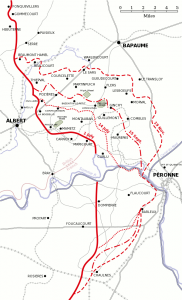
By the time the offensive was called off, the furthest any part of the line had managed to advance was just seven miles forward. As Ferguson says, 'The reality was that at best, if one accepts the British official figure for German casualties of 680,000, the Somme was a draw' Ferguson, The Pity of War, p.293. In total, the British lost 419,654 casualties and the French lost 204,253, making the total Allied loss 623,907. At absolute best, this puts it as a Pyrrhic victoryA victory that is so costly in terms of men and resources that it seems no different from losing. It comes from King Pyrrhus of Epirus, who was fighting against the Romans in the Pyrrhic Wars (c.280BCE). Pyrrhus is supposed to have said 'If we are victorious in one more battle with the Romans, we shall be utterly ruined' (Plutarch, Life of Pyrrhus, 21:8).A victory that is so costly in terms of men and resources that it seems no different from losing. It comes from King Pyrrhus of Epirus, who was fighting against the Romans in the Pyrrhic Wars (c.280BCE). Pyrrhus is supposed to have said 'If we are victorious in one more battle with the Romans, we…A victory that is so costly in terms of men and resources that it seems no different from losing. It comes from King Pyrrhus of Epirus, who was fighting against the Romans in the Pyrrhic Wars (c.280BCE). Pyrrhus is supposed to have said 'If we are victorious in one more battle with the Romans, we…. However, the German official figure was 450,000 lost.
Ferguson, The Pity of War, p.293. In total, the British lost 419,654 casualties and the French lost 204,253, making the total Allied loss 623,907. At absolute best, this puts it as a Pyrrhic victoryA victory that is so costly in terms of men and resources that it seems no different from losing. It comes from King Pyrrhus of Epirus, who was fighting against the Romans in the Pyrrhic Wars (c.280BCE). Pyrrhus is supposed to have said 'If we are victorious in one more battle with the Romans, we shall be utterly ruined' (Plutarch, Life of Pyrrhus, 21:8).A victory that is so costly in terms of men and resources that it seems no different from losing. It comes from King Pyrrhus of Epirus, who was fighting against the Romans in the Pyrrhic Wars (c.280BCE). Pyrrhus is supposed to have said 'If we are victorious in one more battle with the Romans, we…A victory that is so costly in terms of men and resources that it seems no different from losing. It comes from King Pyrrhus of Epirus, who was fighting against the Romans in the Pyrrhic Wars (c.280BCE). Pyrrhus is supposed to have said 'If we are victorious in one more battle with the Romans, we…. However, the German official figure was 450,000 lost. Which Ferguson judges more likely to be the accurate one. By this count, the Somme offensive was a defeat for the Allies. Even a figure for German casualties somewhere in the middle would technically count as an Allied defeat. 'To the British, it was and would remain their greatest military tragedy of the twentieth century, indeed of their national military history'.
Which Ferguson judges more likely to be the accurate one. By this count, the Somme offensive was a defeat for the Allies. Even a figure for German casualties somewhere in the middle would technically count as an Allied defeat. 'To the British, it was and would remain their greatest military tragedy of the twentieth century, indeed of their national military history'.
Others think that, even though the loss of life was terrible, the Somme was a 'bloody victory'. By November 1916, all of the original German defences had been overrun, and the Allies had therefore succeeded in their goal of advancing their front line, although they didn't manage to take the countryside behind. Terraine suggests that the Germans felt defeated, pointing to letters home and reports in their press hinting that the Somme had been a great defeat. To him, the result of the Somme was 'the loss, once and for all, of that intrinsic superiority of quality through peace-time training which the German Army had hitherto enjoyed. Henceforward it was in decline, becoming what its leaders called a 'militia'. The British had been a militia ever since their small Regular Army vanished in 1915; now they were on equal terms, and would get better.' Terraine, 'The Texture of the Somme' In other words, the Battle of the Somme destroyed the professional German army, and from that point on, they would have to rely on reserves, volunteers, and conscripts, much like the British. It therefore evened the playing field, and weakened German morale
Terraine, 'The Texture of the Somme' In other words, the Battle of the Somme destroyed the professional German army, and from that point on, they would have to rely on reserves, volunteers, and conscripts, much like the British. It therefore evened the playing field, and weakened German morale Although others, even those who see the Somme as a success such as Sheffield, have stated there was little weakening of German morale. as well as their defences.
Although others, even those who see the Somme as a success such as Sheffield, have stated there was little weakening of German morale. as well as their defences. The old German army did decline, although perhaps as much as a result of Verdun as of the Somme. It is certainly true that by March 1917, the Germans withdrew twenty miles to the tactically advantageous Hindenburg Line, to which the Battle of the Somme would have been a contributing factor. It is also likely that this loss of German superiority led them into making mistakes, most notably in the U-boatGerman submarine used in the First and Second World Wars. campaign in 1917, which ultimately brought America into the war.
The old German army did decline, although perhaps as much as a result of Verdun as of the Somme. It is certainly true that by March 1917, the Germans withdrew twenty miles to the tactically advantageous Hindenburg Line, to which the Battle of the Somme would have been a contributing factor. It is also likely that this loss of German superiority led them into making mistakes, most notably in the U-boatGerman submarine used in the First and Second World Wars. campaign in 1917, which ultimately brought America into the war. In an effort to break the stalemate on the Western Front in 1917, Germany decided to attack every ship sailing for Britain. It reasoned that Britain without supplies would be weakened and would therefore be easier to defeat. This led them to target American ships, which, together with other acts - such as declaring help for Mexico - changed American public opinion and made it easier for America to enter the war on the side of the Allies.
In an effort to break the stalemate on the Western Front in 1917, Germany decided to attack every ship sailing for Britain. It reasoned that Britain without supplies would be weakened and would therefore be easier to defeat. This led them to target American ships, which, together with other acts - such as declaring help for Mexico - changed American public opinion and made it easier for America to enter the war on the side of the Allies.
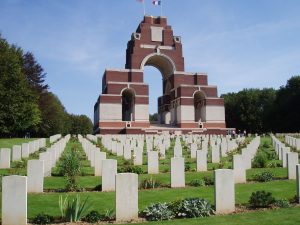
Some have argued that the advanced line at the end of the battle was the best result the Allies could hope for, given the political and technical constraints of the time. Others have suggested that valuable lessons were learnt, even by Haig, and that these lessons were then used to win the war for the Allies. However, even in October Haig was gathering cavalry in preparation for a breakthrough, suggesting that lessons hadn't been learnt by then. Perhaps there is some truth that the Somme marked a turning point in the war, but that reversal of fortune was to be a long time – two full years in fact – coming. Whether or not the Battle of the Somme was a victory or defeat might, then, rest on how much a life is worth.
Things to think about
- Was the Somme a victory or a defeat?
- Was the battle a futile waste of life?
- What impact did the Somme have on the First World War and beyond?
- How did the soldiers on the Somme experience it?
- What level of support was there at the time for the Battle of the Somme, and did this change over time?
- Was Haig a good commander, or was he a butcher?
- What could have been done better?
- How useful were the tanks, and was the Somme a good time to introduce them?
- What value can be placed on an individual life in war?
Things to do
- Many families suffered losses during the First World War. Although those who fought on the Somme are no longer with us, their memories live on through their descendants. Talk to family members and see if anyone from your family was affected: perhaps they still have letters or other memorabilia. You could also try family history sites such as Ancestry for more information.
- Whole towns were affected by the Battle of the Somme thanks to the use of Pals battalions. Was your town one of them? You could look for a war memorial or in the town records to find out more.
- The Imperial War Museum has a wealth of information on the Somme and the First World War in general. You can visit the museum in London, Manchester or Cambridgeshire, or explore their online collections here.
- Although not much remains of the Somme battlefield today, it is possible to visit the various monuments and war graves along the Somme, as well as the museum at Thiepval. Information about the museum, memorials and graveyards, as well as suggested tours can be found here.
Further reading
Due to 2016 being the centenary year of the Battle of the Somme, a vast number of books have been published on the subject. Hugh Sebag-Montifiore has written a good account, basing his research around a number of first-hand experiences in Somme: Into the Breach. Another volume released in time for the anniversary is Richard van Emden's The Somme: The Epic Battle in the Soldiers' own Words and Photographs, which again uses soldiers' own experiences to tell the story. An older book, but still considered one of the best is Lyn MacDonald's Somme. As a break from the harder reading, it is possible to buy the Wipers Times in book format.
- Log in to post comments

